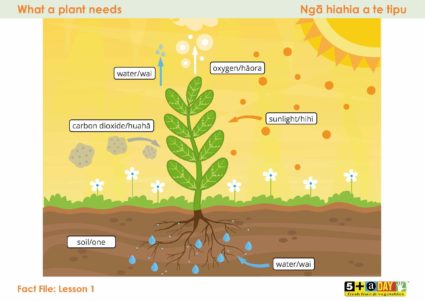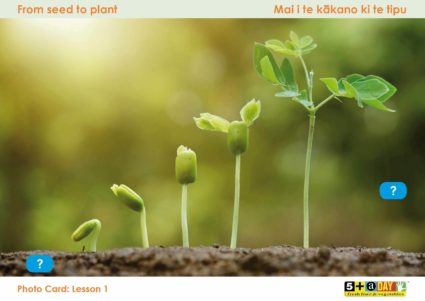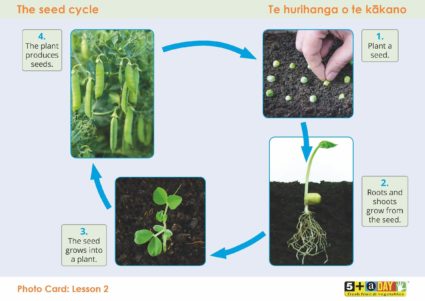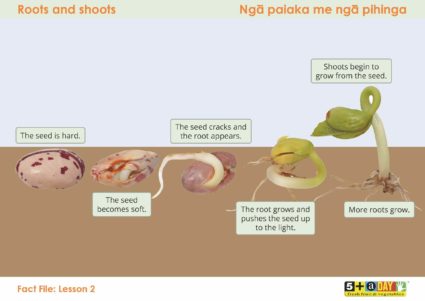Primary
Lesson 2: Growing Beans and Salad Greens
In this lesson, students will continue to explore the process of germination and plant growth. They will discuss how to plant their own seeds and provide all the things a seed needs to become a healthy plant. They will then plant some seeds and monitor the results.

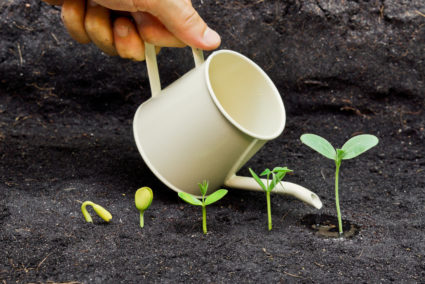
This lesson is featured in our printed resource; Book 1: Growing and Learning with 5+ A Day, Levels 1 & 2.
Order the print version here or download here to print yourself.
Learning Intentions
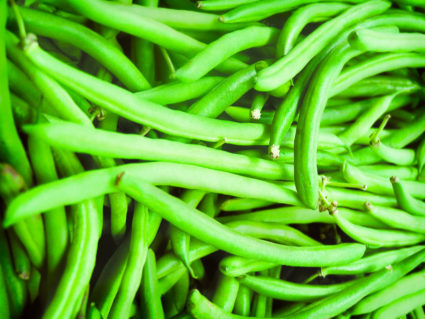
Students will:
- recognise that growing fresh food needs planning and organisation
- understand that growing your own fresh vegetables promotes healthy eating at school and at home.
Possible Achievement Objectives
Science: Levels 1 & 2
LIFE PROCESSES
Students will:
- recognise that all living things have certain requirements so they can stay alive.
ECOLOGY
Students will:
- recognise that living things are suited to their particular habitat.
INVESTIGATING IN SCIENCE
Students will:
- appreciate that scientists ask questions about our world that lead to investigations and that open-mindedness is important because there may be more than one explanation.
Preparation
What You Need
- eBook: Fredge Plants Some Seeds
- Fact File: What a plant needs/Ngā hiahia a te tipu (from Lesson 1)
- Photo Card: From seed to plant/Mai i te kākano ki te tipu (from Lesson 1)
- Fact File: Roots and shoots/Ngā paiaka me ngā pihinga
- Photo Card: The seed cycle/Te hurihanga o te kākano
- Broad bean or runner bean seeds
- Cress seeds or a similar fast-growing micro-green
- Small glass jars and seed-raising mix
- Water
- Resource Sheet: Watch and wait/Mātakitaki, tatari hoki
Additional Resources
- Our Gifted Garden, Junior Journal 49:
https://tinyurl.com/hf56zqg - Seeds, Junior Journal 50:
https://literacyonline.tki.org.... - Dig In, Junior Journal 52:
https://tinyurl.com/htfcfwj - Extraordinary Earthworms, Ready to Read
https://instructionalseries.tki.org.... - Growing Pumpkins, Ready to Read
https://instructionalseries.tki.org....
Key Vocabulary
Students will have met some of these words in Lesson 1. Others should be used and defined in context:
germination/tinakutanga: to start growing from a seed or to sprout
hypothesis/whakapae: an idea or a theory which is tested to see if it happens
moisture/haumakū: water stored in the soil and taken up by the roots of a plant
photosynthesis/ahotakakame: the process by which plants use sunlight to create food from water and carbon dioxide in the air to help them grow
nutrients/taiora: minerals that plants absorb from the soil to help them grow and stay healthy
root hairs/weri: the smaller roots that grow from the main root
shoot/pihi: the growth that appears from the seed and grows towards the light
Learning Opportunity
This practical lesson is a follow-on from Lesson 1. Students will begin to take responsibility for their learning through carrying out their own inquiry. You can act as a facilitator to this learning. The students need to form a simple hypothesis, explain how they will check this, then carry out the experiment and eventually record their results and share them in an appropriate way. As well as monitoring bean germination and growth, students will also plant some fast-growing micro-greens that they can eat after several weeks.
The Lesson
eBook: Fredge Plants Some Seeds
Begin the lesson by sharing the eBook Fredge Plants Some Seeds (click on the cover of the eBook). There is audio for this story, which you can use if you wish or students can take turns to read the text.
The messages in this eBook reinforce the information about growing fresh vegetables from seeds that has been discussed so far and which will be expanded on. For information on using 5+ A Day eBooks, click here.
There are two interactive activities that follow the eBook. They work on a computer, a tablet, or an IWB. They can be used during or at the end of the lesson or in choosing time to reinforce key information from the story. Students will get the most from these activities if you model them first and explain the actions required and the aims of the activity. Then students can do them independently or in pairs.
For Activity 1, drag each item onto the garden in the correct order: soil, compost, seeds, water, and sun. For Activity 2, help keep Fredge’s seeds safe from the blackbirds. Each time a bird swoops down, drag the correct mini-scarecrow onto the bird to scare it off. Use the left-hand scarecrow for the left-hand birds, and the right-hand scarecrow for the right-hand birds.
- What kind of seeds did Fredge plant?/He aha ngā tūmomo kākano kua whakatōngia e a Fredge?
- What did the seeds need to grow into healthy plants? (good soil, water, light, protection from pests)
Explain that we can all grow fresh and delicious vegetables if we plant them correctly and look after them like Fredge did.
Revisiting What a plant needs
Show the students the Fact File: What a plant needs/Ngā hiahia a te tipu from Lesson 1 (click on the image to enlarge, download, and print).
- What things does a plant need to grow and be healthy?
Review each label with students and check their understanding.
- What would happen if one of these things were missing?
Revisiting From seed to plant
Show the students the Photo Card: From seed to plant/Mai i te kākano ki te tipu from Lesson 1 (click on the image to enlarge, download, and print) and discuss the changes they see.
- What does the seed need to start changing like this? (warmth, moisture)
- Has anyone watched a seed growing?/Kua mātakitaki koutou ki te whakatupuranga o te kākano?
- How could we watch what’s happening to Fredge’s beans before they come out of the soil?
Have the students discuss this and share their ideas. One approach is to plant a bean seed in seed-raising mix against the side of a glass jar. If you use a jar, you will need to remove the seed once it has sprouted and replant it as the jar won’t have any drainage.
Another approach is to use moist paper towels instead of seed-raising mix. The students might arrive at different, practical options, and you should allow them to explore these.
Photo Card: The seed cycle/Te hurihanga o te kākano
Before the students plant the seeds, look together at the Photo Card: The seed cycle/Te hurihanga o te kākano (click on the image to enlarge, download, and print).
- Where do you think our bean seeds came from?/Ki o whakaaro, mai i whea o mātou kākano pīni?
- How do we keep on getting fresh and healthy vegetables every year?
Explore the idea that plants make seeds and that’s how new plants grow. Sometimes we eat the seeds (peas/beans); sometimes we eat the plants or their roots (lettuce, carrots).
Have the students work in small groups, each with a jar, some seed-raising mix, and two bean seeds.
If necessary, model how to fill the jar with seed-raising mix and push the bean seeds down into the mix, so they are against the glass of the jar, one on either side.
Fact File: Roots and shoots/Ngā paiaka me ngā pihinga
Now share the Fact File: Roots and shoots/Ngā paiaka me ngā pihinga (click on the image to enlarge, download, and print).
Based on your discussion of the fact file, make a list together of things for the students to look for as they watch the process over time. For example:
- The bean seed becomes soft and cracks.
- A root pops out of the side of the bean.
- The root pushes down into the soil.
- The seed pushes up as the root grows down.
- Tiny root hairs grow off the main root.
- A green shoot appears and starts growing up.
Growing conditions
Now discuss the ways in which you could observe the effects that different growing conditions might have on the seeds.
- What do we need to do to make the seeds grow well? (Add water and keep them warm.)/Me aha tātou kia pai ai te tupu o ngā kākano? (Kīnakihia ki te wai kia mahana.)
- What would happen if we stopped watering the seeds?/Ka pēwhea ngā kākano, inā ka aukatingia te whakawai?
- What if the seeds got really cold?/Ka pēwhea ngā kākano, inā ka makariri?
Ask students to come up with suggestions for altering the conditions for the seeds to see how this affects their growth compared with the seeds that are well looked after. For example:
- Water some seeds every day and some every three days.
- Put some of the jars in a dark place and some in a light place.
- Put some jars in a warm place and several in the fridge.
Within 2–3 days, under ideal growing conditions, the beans should start to develop a root. In another 2–3 days, root hairs will appear, and the shoot will poke its head out of the seed. In another 4–5 days, the stem will push the seed out of the soil and leaves will begin to develop. Of course, it will be a long time before the plants produce anything edible.
To give the students a faster “from planting to eating” experience, have them spread the cress seeds on some damp cotton wool or on a shallow tray filled with seed-raising mix. Keep the seeds and the sprouts damp by spraying them with water. The cress can be clipped and tasted after about 10 days.
Reflect on the Learning
After the groups have planted their beans, give each student a copy of Resource Sheet: Watch and wait/Mātakitaki, tatari hoki (click on the image to enlarge, download, and print). Tell the students that they can use it to record the changes in their bean seeds. They can draw what is happening at four different times and add the date of each observation.
This is also a time to reflect on the learning and to signal the focus for the next lesson, where students will look at eating a rainbow of colours and serving sizes, ensuring they eat 5+ A Day to prepare for exercise.


